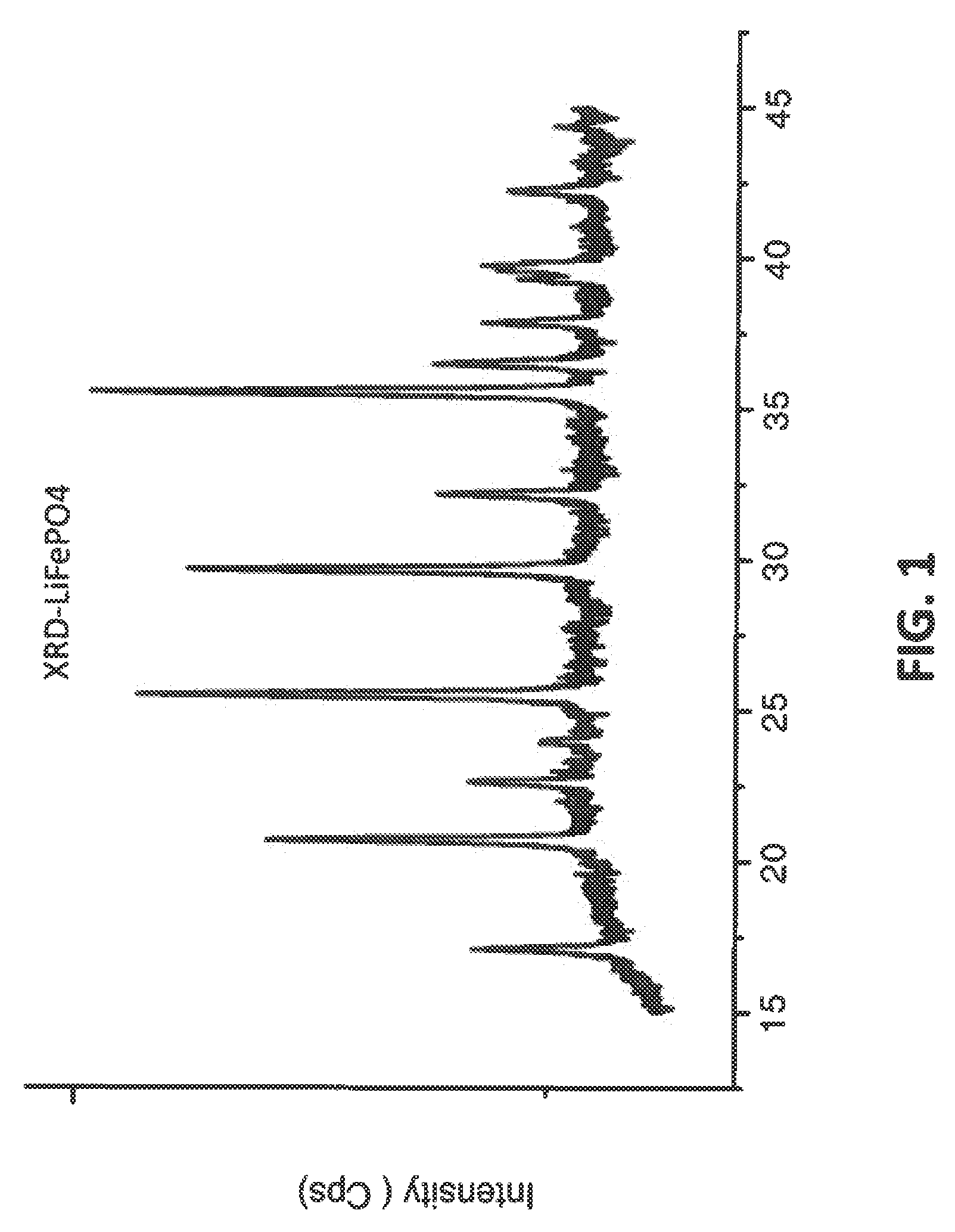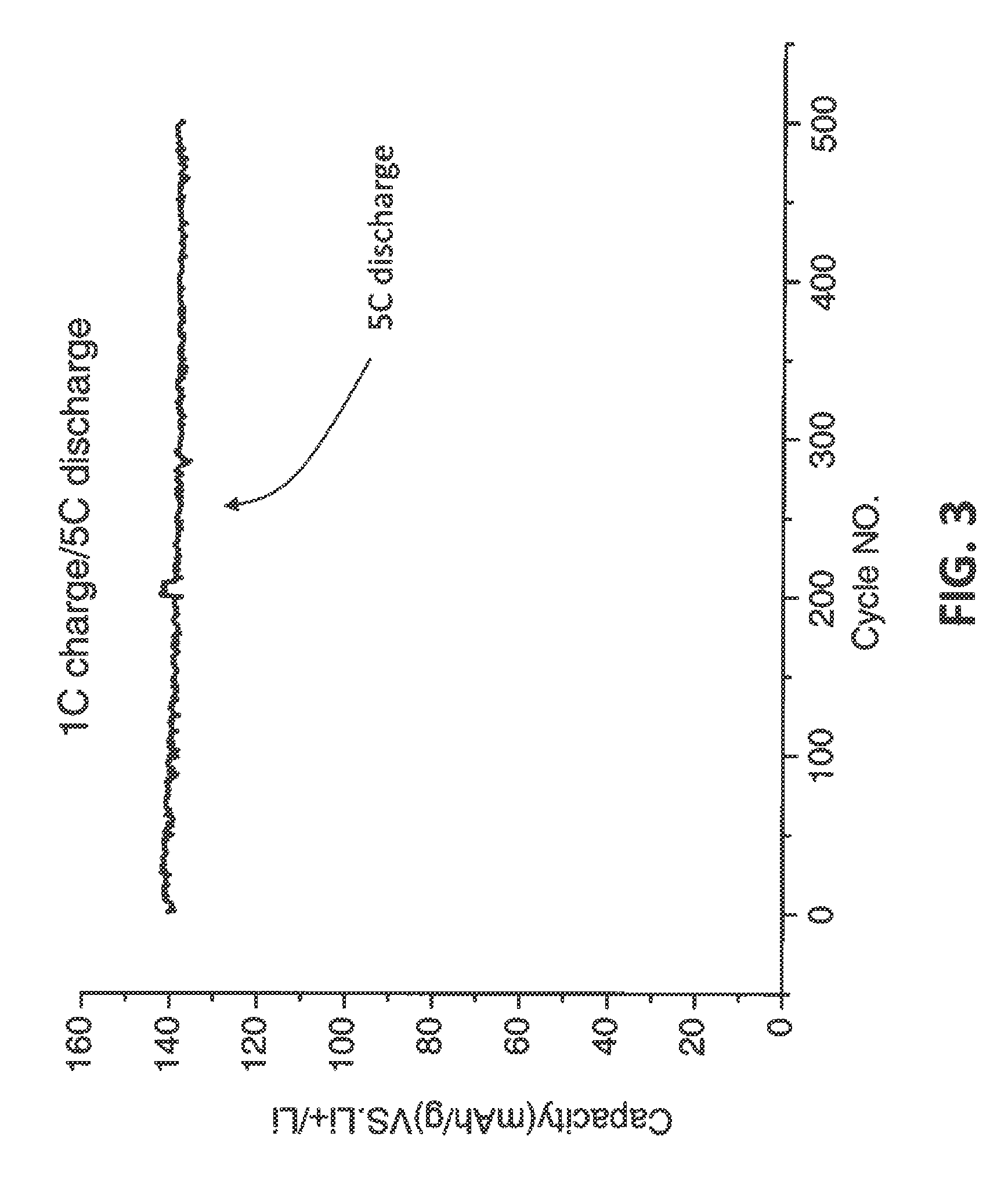Novel nanoscale solution method for synthesizing lithium cathode active materials
a lithium cathode active material and nano-scale solution technology, applied in the direction of non-aqueous electrolyte accumulator electrodes, cell components, electrical equipment, etc., can solve the problems of low thermal stability, high cost, toxicity and relatively low thermal stability,
- Summary
- Abstract
- Description
- Claims
- Application Information
AI Technical Summary
Benefits of technology
Problems solved by technology
Method used
Image
Examples
example 1
Synthesis of LiFePO4 Cathode Active Material
[0044]In an embodiment of the invention, LiFePO4 can be synthesized as the following. Reagents used in this investigation included Ferro (II) sulfate, Sodium hydroxide, and ammonium hydroxide (28.5%). All solutions were prepared with deionized (DI) water which was deaerated by boiling for 10 min. A co-precipitation reactor with a 2 L jacketed reaction vessel equipped with pH and temperature controllers was used in this investigation. Reagents were added using digital peristaltic pumps, and sodium hydroxide addition was automatically controlled by the pH controller and added as required by a peristaltic pump on the reactor. Reaction contents were maintained at a temperature of 60° C., and the contents of the reactor were stirred by an overhead stirrer at 2000 rpm. Nitrogen was bubbled 80 sccm into the reactor throughout the reaction. A volume of 1 L of a 1 M NH4OH (aq) solution made in deaerated water was heated to 60° C. The reaction proce...
example 3
Synthesis of LiFe0.33Co0.33Mn0.33PO4 Cathode Active Material
[0052]Reagents used in this investigation included Ferro (II) sulfate, manganese sulfate monohydrate (98%), cobalt sulfate heptahydrate (98%), sodium hydroxide, and ammonium hydroxide (28.5). All solutions were prepared with deionized (DI) water which was deaerated by boiling for 10 min. The reaction for the Fe0.33Co0.33Mn0.33(OH)2 is the same as in example 1. After reaction, the solid material was filtered and washed with deaerated DI water in several rinses.
[0053]The dried mixture was then well-mixed with a solution of a mixture of LiOH (Alfa Aesar, 99% purity) and NH4H2PO4 (Alfa Aesar, 99% purity) and PEG polymer to obtain a homogeneous mixture. After removing the solvent (water), the dried mixture was calcined at the final temperature (1000° K.) in inert gas flow to obtain the final LiFe0.33Co0.33Mn0.33PO4 composite materials. In various embodiments of the invention, the mixture can be calcined above a lower limit of ap...
example 4
Synthesis of LiFe0.5Mn0.3Ni0.2PO4 Cathode Active Material
[0055]Reagents used in this investigation included Ferro (II) sulfate, manganese sulfate monohydrate (98%), nickel sulfate heptahydrate (98%), sodium hydroxide, and ammonium hydroxide (28.5). All solutions were prepared with deionized (DI) water which was deaerated by boiling for 10 min. The reaction for the Fe0.5Mn0.3Ni0.2(OH)2 is the same as in the example 1. After reaction, the solid material was filtered and washed with deaerated DI water in several rinses.
[0056]The dried mixture was then well-mixed with a solution of a mixture of LiOH (Alfa Aesar, 99% purity) and NH4H2PO4 (Alfa Aesar, 99% purity) and PEG polymer to obtain a homogeneous mixture. After removing the solvent, the dried mixture was calcined at the final temperature (1000° K.) in inert gas flow to obtain the final LiFe0.5Mn0.3Ni0.2PO4 composite materials. In various embodiments of the invention, the mixture can be calcined above a lower limit of approximately 7...
PUM
| Property | Measurement | Unit |
|---|---|---|
| temperature | aaaaa | aaaaa |
| temperature | aaaaa | aaaaa |
| volume | aaaaa | aaaaa |
Abstract
Description
Claims
Application Information
 Login to View More
Login to View More - R&D
- Intellectual Property
- Life Sciences
- Materials
- Tech Scout
- Unparalleled Data Quality
- Higher Quality Content
- 60% Fewer Hallucinations
Browse by: Latest US Patents, China's latest patents, Technical Efficacy Thesaurus, Application Domain, Technology Topic, Popular Technical Reports.
© 2025 PatSnap. All rights reserved.Legal|Privacy policy|Modern Slavery Act Transparency Statement|Sitemap|About US| Contact US: help@patsnap.com



